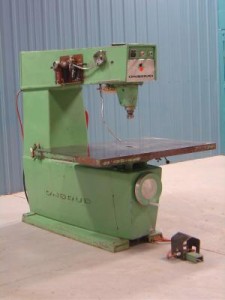 From creating mortises to cutting intricate designs, a router can accomplish numerous woodworking tasks. But how well you’re able to accomplish those tasks depends in part on the type of router you use. Today, there are three basic types of routers found in woodworking operations worldwide: handheld, commercial floor standing, and CNC. The type of router that woodworkers need depends on two factors: their operation’s production rate, and the type of work to be performed. Below, we examine the aforementioned types of routers in terms of production rate and woodwork.
From creating mortises to cutting intricate designs, a router can accomplish numerous woodworking tasks. But how well you’re able to accomplish those tasks depends in part on the type of router you use. Today, there are three basic types of routers found in woodworking operations worldwide: handheld, commercial floor standing, and CNC. The type of router that woodworkers need depends on two factors: their operation’s production rate, and the type of work to be performed. Below, we examine the aforementioned types of routers in terms of production rate and woodwork.
1. Handheld
A handheld router comes in two basic types: fixed base and plunge, with the latter offering the more flexibility due its ability to be placed anywhere on a wood piece. But, even with their increased flexibility, plunge designs, like fixed base designs, are typically used by woodworkers that experience a low to moderate production rate, and that don’t need a router for the production of intricate designs.
2. Commercial Floor Standing
Most floor standing models are the equivalent of handheld models with the added benefits of a stronger motor, a flat space on which to place wood pieces, and the accommodation of more router bits. For woodworkers that find these bonuses helpful, floor standing models can be a boon. Otherwise, they could just be a more expensive version of handhelds.
3. CNC
With their multiple cutter heads (as many as four) and their ability to cut along three axes, CNC models offer dramatically different capabilities than the models above. Available in different sizes, the routers’ cutter heads are controlled by a computer capable of storing customized cutting instructions, allowing the replication of multiple intricate pieces in a short amount of time. In some instances, woodworkers use large CNC routers to produce such pieces as stringers for staircases.
Purchasing Used Routers
Due to their affordable price and short lifespan compared to floor standing and CNC models, handheld routers are best purchased new. But, in the case of the former two, buying used can result in five figure savings, or even six figure savings in the case of a large CNC. But the savings won’t mean anything unless you get a machine that offers reliability, making it crucial to observe some time-tested tips for buying used woodworking machinery: (1) buy from professional sellers of used woodworking machines and avoid amateur ones (e.g. unlicensed Craigslist sellers and eBay merchants); (2) check a seller’s record at the Better Business Bureau, avoiding sellers that have unresolved customer complaints; (3) buy equipment that has an excellent maintenance history as proven by a vigilant logged service record; and (4) inspect the machinery in first person before buying it, or have a trusted third party perform the inspection for you.




